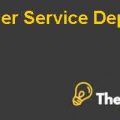
1.0. Introduction
The business environment is changing rapidly with companies expanding their reach to global markets. The new markets, global expansion, changing trends and complexity of business require more aggressive approach to increase market share or even keep at stable position. In such an environment, it is difficult to keep competitive advantage as it keeps on changing. Organizations need to be innovative and come up with new ideas frequently to keep a competitive edge. It can be achieved through involvement of employees at different levels in an organization. This brings in the idea of Organizational Inclusion, which is strongly linked with diversity inside a company. It is relatively a new area of exploration so the focus of this literature review is Organizational Inclusion or Inclusion in Organizations while linking it with diversity.
However, the purpose of the report is to explore meta-analysis’ viability as a research tool to help professionals in making decisions about dynamic and complex challenges facing their organization. This report will also explain the definition, purpose and the process of conducting Meta-analysis, research, as well as the key issues and emerging trends are associated with this research type. Meta-analysis allows organizational professionals to determine if it is suitable for the application in their circumstances so that they can become confident consumers of Meta-analytic results.
Before the institution of meta-analysis, researchers often used to sum up the findings of various studies by aligning together similar aspects of the research data. Meta-analysis aims to establish the facts more accurately than can be done in a conventional narrative review. By using it, we can discover the patterns of relatively invariant underlying relations and causalities, the establishment of which will constitute the general principle and growing awareness.
Meta-Analysis Defined
The Meta-analysis seeks to reconcile the differences amongst a multitude of research literature. In simple terms, meta-analysis is a quantitative technique for combining results of multiple studies with a similar hypothesis to clarify findings, when performed properly; it generates a conclusive answer to a complex issue from a conflicting and the in congruent research body. Particularly, it is useful for reconciling different results from studies on the same topic. Meta-analysis research also establishes the strengths and weaknesses of prior research studies using quantitative measures.
Latham and Lee (1986) suggest that meta-analysis of studies of the impact of goal setting are not worth the effort because about half of the known studies of goal setting are lost when reviewed through meta-analysis and existing reviews provide sufficient accounts of the effects of goals (e.g., Locke, Shaw, Saari, & Latham, 1981). On the other hand, as one becomes experienced with meta-analysis, those operations should become more efficient and cost-effective, hence narrowing the gap between meta-analysis and narrative reviewing. Furthermore, narrative reviews may often require more time in thought, discussion, and writing than does the meta-analysis, thereby further narrowing that gap. Therefore, generalization is not practical, and cost-benefit analysis should be made in each case. Overall, there is no clear advantage of meta-analysis over narrative reviews or vice versa. They differ in various relevant parameters, and reviewers must decide, which approach best meets their objectives and resources, taking account also of the available body of literature. Each approach is likely to continue to occupy a legitimate niche in the field of organizational behavior.Organizational Inclusion Case Solution
2.0. Analysis
The concepts of diversity and inclusion are different yet closely related (Nair & Vohra, 2015). Diversity mostly refers to demographic composition of group/organization, while inclusion is focused on participation and involvement of the workforce (Roberson, 2006). The definition of organization inclusion is still under debate as the concept is relatively new. Inclusion in organizational context is referred to freedom of contribution (Miller, 1998), sense of belongingness (Lirio, et al., 2008), employee acceptance (Pelled, et al., 1999) and/or treatment as valued member of group (Shore, et al., 2011). The emphasis in inclusion is given on the treatment of employee and giving them freedom to participate. Finally, there is a sense of feeling that the employees’ ideas and knowledge is valued in decision making. The idea of inclusion does not make much sense without having diversity in an organization. According to a study by Forbes (2011), diversity is the major component to bring about innovation as agreed by 85% of the respondents and retention of talent. However, such a diversified talent is of no use if not motivated to participate and share ideas. Similarly, employee engagement is different but related concepts. Employee engagement is the resulting factor of diversity and inclusion. Employees feel included (inclusion) based on two perceptions (i) respect and fairness, (ii) unique value and belonging.............................
This is just a sample partial case solution. Please place the order on the website to order your own originally done case solution.












